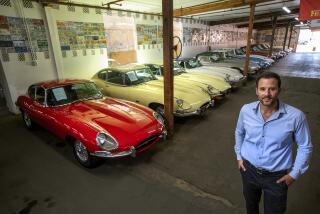Club Car Villager 2+2: Great for gabbing with pedestrians
- Share via
If you want to feel like a goodwill ambassador, take a street-legal golf cart for a spin. You’ll get plenty of waves, smiles and ride-along offers from wannabe passengers.
You’ll also get lots of incredulous stares, questions and requests from concerned friends that you call them upon arriving home.
At least that was my experience in the week I commuted to work in the Club Car Villager 2+2.
The four-passenger Villager is the first consumer-oriented low-speed vehicle, or LSV, from Club Car, the world’s largest manufacturer of small, plug-in electric vehicles. Late last year, the Augusta, Ga., company expanded its vehicular offerings from the golf course to the street, having recognized a growing market for economical, zero-emission urban transport.
That market got a major boost in 2009 thanks to a generous federal tax credit that sliced the vehicle’s cost by almost half, to $4,342 from $8,510. This year and next, there’s less free money on the table, but there’s still some. Buyers of LSVs are eligible for a 10% federal tax credit through Dec. 31, 2011.
Price and incentives were part of the reason I wanted to test the Villager. I was also interested in seeing how the driving experience might compare with the mass-market, passenger-car plug-ins that are coming on the market later this year. LSVs are not only significantly less expensive to purchase than full-size electric vehicles, they also cost less to operate because they are lighter weight and their batteries and motors are smaller, so they require less electricity to operate and have an even smaller carbon footprint.
Comparing the Villager to Chevrolet’s Volt is, admittedly, like asking my 7-year-old to shoot hoops with Kobe Bryant. These tiny, bare-bones vehicles are purely for driving short distances or running errands. They are best suited for people who live in gated communities in mild climates and who don’t care how long it takes them to get wherever it is they’re going. Still, these vehicles could probably eliminate at least one gas guzzler for a lot of families.
According to the U.S. Department of Transportation, an LSV such as the Villager is a motorized, four-wheeled vehicle weighing no more than 3,000 pounds that must travel faster than 20 mph but can’t exceed 25 mph on a flat, paved surface. The Villager 2+2 meets the criteria. Its maximum speed was 25 mph, unless I was traveling downhill, in which case I got it up to a whopping 27. Despite their restricted speeds, LSVs are legal in California on any street designated for 35 mph, which is mostly where I took it.
Sharing the road with vehicles traveling at least 40% faster was a bit unsettling. The Villager zips quickly off the line from a green light. But after reaching about 12 mph, it just creeps to its top speed, which left me poking along in the right lane while cars, trucks and buses whizzed by. I felt the wind of passing vehicles, inhaled their exhaust, heard their stereos.
I even spoke with a lot of them. Lacking side doors and windows, the Villager is a social vehicle that invites conversation everywhere it goes.
I had more talks with strangers while driving the Villager 2+2 than I’ve had in the years I’ve driven Volvos. And I had them with people of varying ethnicities, ages and walks of life, from young Latino pedestrians in Chinatown, to a middle-aged Asian BMW driver downtown to an older Lamborghini driver on the West side, all of them asking the usual questions that accompany the driving of electrics: How fast? How far? How much?
My answers: “Not very,” “about 40 miles” and “about $7,500.”
Driving a golf cart in L.A. is not for drivers who like to tune out behind the wheel. In fact, this 5-horsepower vehicle requires hypervigilance. The Insurance Institute for Highway Safety has raised concerns about the safety of low-speed vehicles if they crash. Although the Villager meets all federal safety requirements for such a vehicle, the main features protecting its drivers are the aluminum I-Beam frame, its roof, a glass windshield and seatbelts. So I found myself driving the Villager the same way I ride a motorcycle: as if everyone else on the road has just been freed from the slammer.
At least the Villager is more conspicuous than a motorcycle or bicycle. Golf carts, for some reason, attract the eye in a way even high-end sports cars don’t. Everyone else on the road knows you’re there; whether they behave respectfully is another matter.
Unlike traditional cars, there are few distractions for drivers inside the Villager. There isn’t a radio, or even a clock. In fact, the Villager has none of the amenities that come standard in most modern-day passenger vehicles. The turn signals have to be canceled manually. Even the digital speedometer on the steering wheel stem is a factory- or dealer-installed option; it isn’t stock.
The version I was driving had no storage, unless I counted the glove compartment and the car’s six cup holders. Fresh from the showroom floor, the base model was impractical for a grocery run, unless all I wanted were drinks. Aftermarket accessories include a custom dash with a front storage compartment (for $273) and a rear storage compartment (for $180-$220) that would replace the backward-facing rear bench seat with a trunk, effectively subtracting the “+2” from the Villager 2+2 name and turning this four-seater into a cozy couple buggy. Adding both storage compartments would provide enough room to stow a clutch-style purse and a few shopping bags.
This isn’t a vehicle for women. Lacking doors and storage, there was no place to put my purse except for on my arm. Placing it on the bench seat or floor ran the risk of it sliding into an intersection in a tight turn. And the leaf-spring suspension front and rear was, at best, primitive. Had I indulged my raging coffee habit and employed all six cup holders, they would have needed lids.
Long arms also help. Because the front bench seat houses the vehicle’s batteries, it can’t be moved forward. The seat belt is also exceptionally tight, so it prevents drivers from even scooting forward on the seat.
Performance is not this vehicle’s strong suit. Nor was it Club Car’s intention. The Villager 2+2 is essentially a souped-up golf cart that targets drivers who want to run short errands without turning the ignitions on their gas guzzlers. Making it street legal was a matter of adding safety equipment required by NHTSA.
The Villager 2+2 costs roughly a third as much as a Volt or Nissan Leaf (after applying currently available incentives for both types of vehicle), but it offers even less than a third of the technology, so it requires a recalibration of vehicular expectations. Factoring out its electric powertrain, it’s an exceptionally rudimentary vehicle. The brakes aren’t discs but drums, which are adequate for a vehicle that travels this slowly, though they aren’t responsive like a car’s. The 48-volt battery pack is the lead-acid type, rather than lighter-weight but more energy-dense (and expensive) lithium ion that will be used in many soon-to-be-released electric cars.
On the upside, the Villager travels a lot farther per charge than Club Car claims. Club Car estimates 20 to 30 miles. When I drove the Villager 18 miles from downtown L.A. to Santa Monica on Wilshire Blvd., I arrived with 60% of the charge still left in the battery. Plugging into a 120-volt charger for 90 minutes and heading back to where I started, I still had 60% of the charge on my battery when I returned to The Times. That’s impressive.
So was its ability to handle hills. Part of my daily commute from Northeast L.A. to downtown includes a milelong detour up a hill to my son’s school. This hill has been the bane of many an electric bicycle, so I was curious to see how the Villager 2+2 fared. It made it up the hill without a problem, albeit slowly — at an average speed of 11 mph.
Overall, I thought the Villager 2+2 was a good, low-budget electric option for spending less time in greenhouse-gas-emitting cars. But the wild streets of L.A. are probably not its most appropriate environment. A gated community with far less traffic would be a better match.






